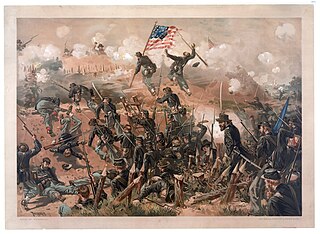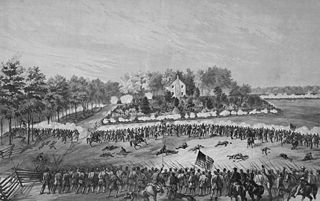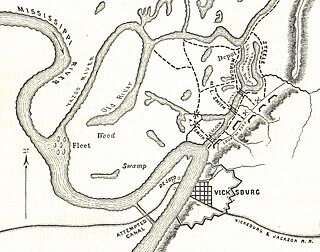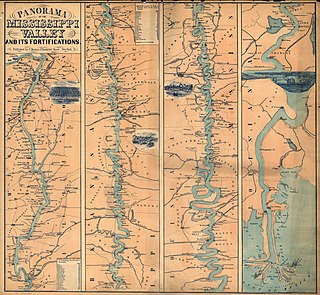
The siege of Vicksburg was the final major military action in the Vicksburg campaign of the American Civil War. In a series of maneuvers, Union Major General Ulysses S. Grant and his Army of the Tennessee crossed the Mississippi River and drove the Confederate Army of Mississippi, led by Lieutenant General John C. Pemberton, into the defensive lines surrounding the fortress city of Vicksburg, Mississippi, leading to the successful siege and Confederate surrender.

The Battle of Arkansas Post, also known as Battle of Fort Hindman, was fought from January 9 to 11, 1863, along the Arkansas River at Arkansas Post, Arkansas, as part of the Vicksburg campaign of the American Civil War. Confederate forces had constructed a fort known as Fort Hindman near Arkansas Post in late 1862. Also in late 1862, Major General John A. McClernand of the Union Army was authorized to recruit troops in the midwest in preparation for an expedition down the Mississippi River against Vicksburg, Mississippi. Union Major General Ulysses S. Grant began an overland campaign against Vicksburg along the Mississippi Central Railroad in November. Grant and Major General Henry Halleck did not trust McClernand, and machinated start the riverine movement south against Vicksburg under the command of Major General William T. Sherman before McClernand could arrive. Sherman's movement was defeated in the Battle of Chickasaw Bayou in late December, and Confederate cavalry raids forced Grant to abandon his overland campaign.

The Vicksburg campaign was a series of maneuvers and battles in the Western Theater of the American Civil War directed against Vicksburg, Mississippi, a fortress city that dominated the last Confederate-controlled section of the Mississippi River. The Union Army of the Tennessee under Major General Ulysses S. Grant gained control of the river by capturing this stronghold and defeating Lieutenant General John C. Pemberton's forces stationed there.

The Battle of Jackson was fought on May 14, 1863, in Jackson, Mississippi, as part of the Vicksburg campaign during the American Civil War. After entering the state of Mississippi in late April 1863, Major General Ulysses S. Grant of the Union Army moved his force inland to strike at the strategic Mississippi River town of Vicksburg, Mississippi. The Battle of Raymond, which was fought on May 12, convinced Grant that General Joseph E. Johnston's Confederate army was too strong to be safely bypassed, so he sent two corps, under major generals James B. McPherson and William T. Sherman, to capture Johnston's position at Jackson. Johnston did not believe the city was defensible and began withdrawing. Brigadier General John Gregg was tasked with commanding the Confederate rear guard, which fought Sherman's and McPherson's men at Jackson on May 14 before withdrawing. After taking the city, Union troops destroyed economic and military infrastructure and also plundered civilians' homes. Grant then moved against Vicksburg, which he placed under siege on May 18 and captured on July 4. Despite being reinforced, Johnston made only a weak effort to save the Vicksburg garrison, and was driven out of Jackson a second time in mid-July.

The Battle of Milliken's Bend was fought on June 7, 1863, as part of the Vicksburg Campaign during the American Civil War. Major General Ulysses S. Grant of the Union Army had placed the strategic Mississippi River city of Vicksburg, Mississippi, under siege in mid-1863. Confederate leadership erroneously believed that Grant's supply line still ran through Milliken's Bend, Louisiana, and Major General Richard Taylor was tasked with disrupting it to aid the defense of Vicksburg. Taylor sent Brigadier General Henry E. McCulloch with a brigade of Texans to attack Milliken's Bend, which was held by a brigade of newly-recruited African American soldiers. McCulloch's attack struck early on the morning of June 7, and was initially successful in close-quarters fighting. Fire from the Union gunboat USS Choctaw halted the Confederate attack, and McCulloch later withdrew after the arrival of a second gunboat. The attempt to relieve Vicksburg was unsuccessful. One of the first actions in which African American soldiers fought, Milliken's Bend demonstrated the value of African American soldiers as part of the Union Army.

The Battle of Big Black River Bridge was fought on May 17, 1863, as part of the Vicksburg Campaign of the American Civil War. During the war, the city of Vicksburg, Mississippi, was a key point on the Mississippi River. On April 30, 1863, a Union army commanded by Major General Ulysses S. Grant began crossing onto the east side of the Mississippi River as part of a campaign against Vicksburg. After engaging and defeating Confederate forces in several intermediate battles, Grant's army defeated Lieutenant General John C. Pemberton's troops at the decisive Battle of Champion Hill on May 16. During the retreat from Champion Hill battlefield, one division of Pemberton's army, commanded by Major General William W. Loring, was cut off from Pemberton's main body. Pemberton, retreating westwards towards Vicksburg, did not know the location of Loring's division, and he held a bridgehead on the east side of the Big Black River to cover Loring's anticipated withdrawal across the river on the morning of May 17.

Grant's Canal was an incomplete military effort to construct a canal through De Soto Point in Louisiana, across the Mississippi River from Vicksburg, Mississippi. During the American Civil War, the Union Navy attempted to capture the Confederate-held city of Vicksburg in 1862, but were unable to do so with army support. Union Brigadier-General Thomas Williams was sent to De Soto Point with 3,200 men to dig a canal capable of bypassing the strong defenses around Vicksburg. Despite being assisted by locally enslaved people, Williams was unable to finish constructing the canal due to disease and falling river levels, and the project was abandoned until January 1863, when Union Major-General Ulysses S. Grant took an interest in the project.

The Battle of Chickasaw Bayou, also called the Battle of Walnut Hills, fought December 26–29, 1862, was the opening engagement of the Vicksburg Campaign during the American Civil War. Confederate forces under Lt. Gen. John C. Pemberton repulsed an advance by Union Maj. Gen. William T. Sherman that was intended to lead to the capture of Vicksburg, Mississippi.

The Battle of Raymond was fought on May 12, 1863, near Raymond, Mississippi, during the Vicksburg campaign of the American Civil War. Initial Union attempts to capture the strategically important Mississippi River city of Vicksburg failed. Beginning in late April 1863, Union Major General Ulysses S. Grant led another try. After crossing the river into Mississippi and winning the Battle of Port Gibson, Grant began moving east, intending to turn back west and attack Vicksburg. A portion of Grant's army consisting of Major General James B. McPherson's 10,000 to 12,000-man XVII Corps moved northeast towards Raymond. The Confederate commander of Vicksburg, Lieutenant General John C. Pemberton, ordered Brigadier General John Gregg and his 3,000 to 4,000-strong brigade from Jackson to Raymond.

USS Marmora was a sternwheel steamer that served in the Union Navy from 1862 to 1865, during the American Civil War. Built in 1862 at Monongahela, Pennsylvania, as a civilian vessel, she was purchased for military service on September 17 and converted into a tinclad warship. Commissioned on October 21, the vessel served on the Yazoo River beginning the next month. She encountered Confederate naval mines on the Yazoo on December 11, and was present the next day when the ironclad USS Cairo was sunk by two mines. After further service on the Yazoo during the Battle of Chickasaw Bayou in late December, Marmora was assigned in January 1863 to a fleet that was preparing to operate against Confederate Fort Hindman, but was not present when the fort surrendered on January 11.

The Battle of Grand Gulf was fought on April 29, 1863, during the American Civil War. Union Army forces commanded by Major General Ulysses S. Grant had failed several times to bypass or capture the Confederate-held city of Vicksburg, Mississippi, during the Vicksburg campaign. Grant decided to move his army south of Vicksburg, cross the Mississippi River, and then advance on the city. A Confederate Army division under Brigadier General John S. Bowen prepared defenses—Forts Wade and Cobun—at Grand Gulf, Mississippi, south of Vicksburg. To clear the way for a Union crossing, seven Union Navy ironclad warships from the Mississippi Squadron commanded by Admiral David Dixon Porter bombarded the Confederate defenses at Grand Gulf on April 29. Union fire silenced Fort Wade and killed its commander, but the overall Confederate position held. Grant decided to cross the river elsewhere.

USS Indianola was a casemate ironclad that served as a river gunboat for the Union Navy during the American Civil War. A side-wheel steamer also equipped with two screw propellers, Indianola was built in Cincinnati, Ohio in 1862 by Joseph Brown before being taken by Union authorities while still incomplete, in response to a perceived Confederate threat to Cincinnati. After completion, the vessel briefly served on the Mississippi River and the Yazoo River before being sent downstream of Vicksburg, Mississippi in February 1863, to support the naval ram USS Queen of the West, which was operating against Confederate shipping.

USS Linden was a steamer acquired by the Union Navy during the American Civil War. She was used by the Navy to patrol navigable waterways of the Confederacy to prevent the South from trading with other countries.
The Battle of Richmond was fought on June 15, 1863, near Richmond, Louisiana, during the Vicksburg campaign of the American Civil War. Major General John George Walker's division of Confederate troops, known as Walker's Greyhounds had attacked Union forces in the Battle of Milliken's Bend and the Battle of Lake Providence earlier that month in hopes of relieving some of the pressure on the Confederate troops besieged in Vicksburg, Mississippi. While both of Walker's strikes were failures and the Confederates withdrew to Richmond, Union Major General Ulysses S. Grant still viewed the presence of Walker's men at Richmond to be a threat. On June 14, the Mississippi Marine Brigade and the infantry brigade of Brigadier General Joseph A. Mower were sent to attack the Confederates at Richmond.

The Steele's Bayou expedition was a joint operation of Major General Ulysses S. Grant's Army of the Tennessee and Rear Admiral David D. Porter's Mississippi River Squadron, conducted as a part of the Vicksburg Campaign of the American Civil War. Its aim was to move Union forces from the Mississippi River to a point on the Yazoo River upstream of Confederate Lieutenant General John C. Pemberton's defenses of Vicksburg. To avoid enemy artillery in place on the bluffs to the east of the city, the expedition would leave the Yazoo and proceed indirectly on a route through a series of waterways in the flood plain to the east of the Mississippi.

The Battle of Lake Providence was fought on June 9, 1863, during the Vicksburg campaign of the American Civil War. Confederate troops from the Trans-Mississippi Department were trying to relieve Union pressure during the Siege of Vicksburg. Major General Richard Taylor, primarily using Walker's Greyhounds, prepared a three-pronged attack against Union positions at Milliken's Bend, Young's Point, and Lake Providence, which was scheduled to take place on June 7. The strike against Lake Providence was conducted by 900 men led by Colonel Frank Bartlett.

The Mississippi River was an important military highway that bordered ten states, roughly equally divided between Union and Confederate loyalties.

Black Terror was a fake warship used in the American Civil War to bluff Confederate forces into destroying the partially-salvaged remains of the ironclad USS Indianola. Union forces were advancing to control the Mississippi River and had made two attempts to capture Vicksburg, Mississippi, in 1862. Early the next year, the ram USS Queen of the West moved downriver to interfere with Confederate shipping on the Red River; Indianola was sent down a few days later. However, Queen of the West was disabled and captured after an encounter with Confederate field fortifications, and Indianola was severely damaged on February 24 after an attack by the repaired Queen of the West and CSS William H. Webb.

The Duckport Canal was an unsuccessful military venture by Union forces during the Vicksburg campaign of the American Civil War. Ordered built in late March 1863 by Major General Ulysses S. Grant, the canal stretched from the Mississippi River near Duckport, Louisiana, to New Carthage, Louisiana, and utilized a series of swampy bayous for much of its path. It was intended to provide a water-based supply route for a southward movement against the Confederate-held city of Vicksburg, Mississippi, as high water levels made overland travel difficult. Manual digging was provided by 3,500 soldiers from Grant's army and was finished on April 12. The next day, the levee separating the canal cut and the Mississippi River was breached, and water flowed into the canal. Trees that had grown up in the bayous and falling water levels that reached as shallow as 6 inches (15 cm) at one point hampered the use of the canal, and the project was abandoned on May 4. Grant moved men and supplies through the overland route, which had been made more accessible by the same falling water levels that doomed the canal. After some inland maneuvering and a lengthy siege, Vicksburg surrendered on July 4, marking a significant turning point in the war.

Steele's Greenville expedition took place from April 2 to 25, 1863, during the Vicksburg campaign of the American Civil War. Union forces commanded by Major General Frederick Steele occupied Greenville, Mississippi, and operated in the surrounding area, to divert Confederate attention from a more important movement made in Louisiana by Major General John A. McClernand's corps. Minor skirmishing between the two sides occurred, particularly in the early stages of the expedition. Over 1,000 slaves were freed during the operation, and large quantities of supplies and animals were destroyed or removed from the area. Along with other operations, including Grierson's Raid, Steele's Greenville expedition distracted Confederate attention from McClernand's movement. Some historians have suggested that the Greenville expedition represented the Union war policy's shifting more towards expanding the war to Confederate social and economic structures and the Confederate homefront.





















